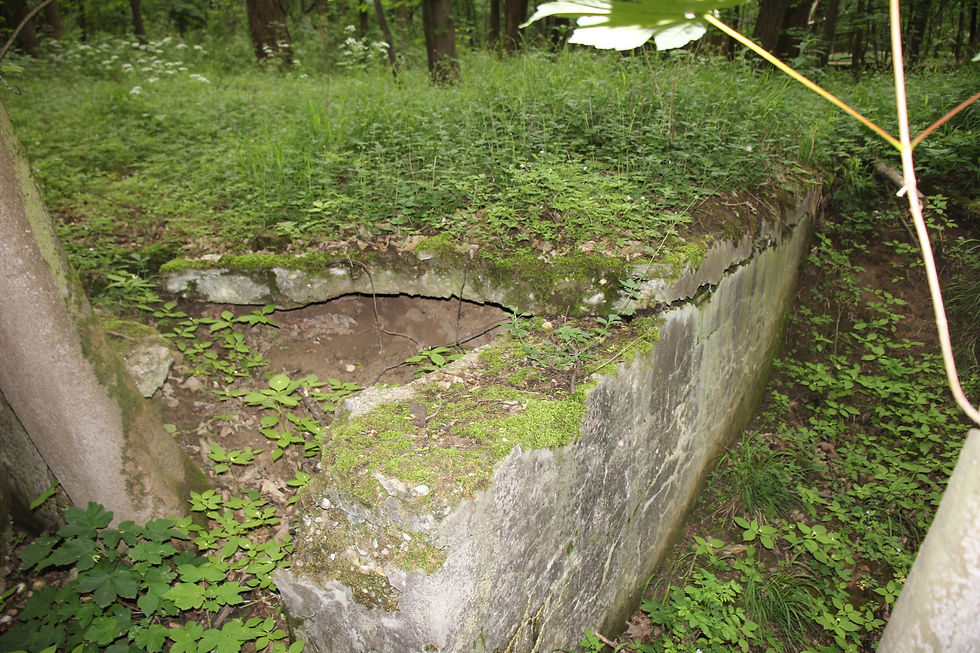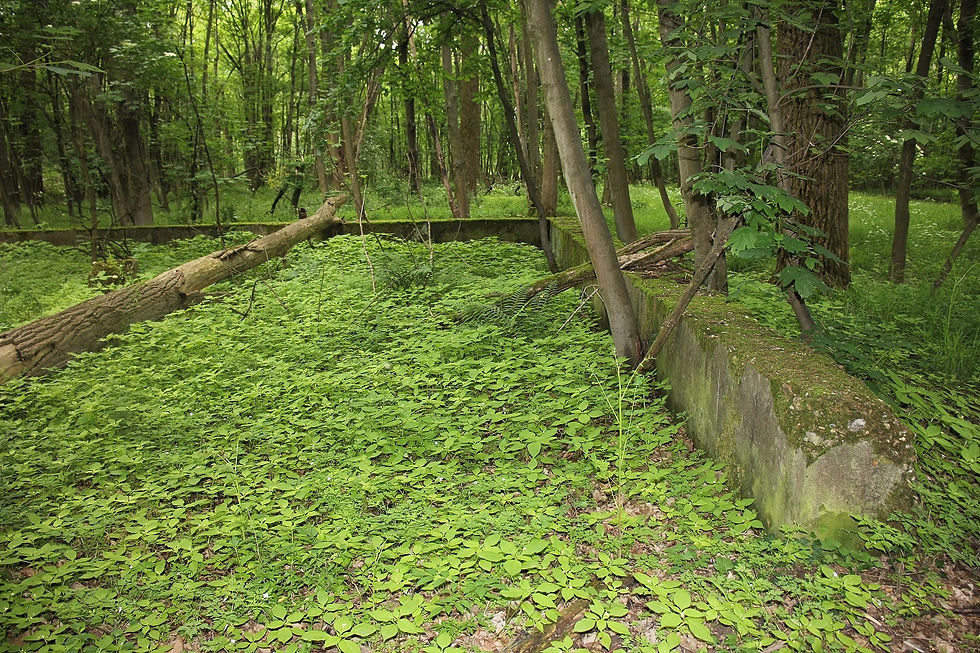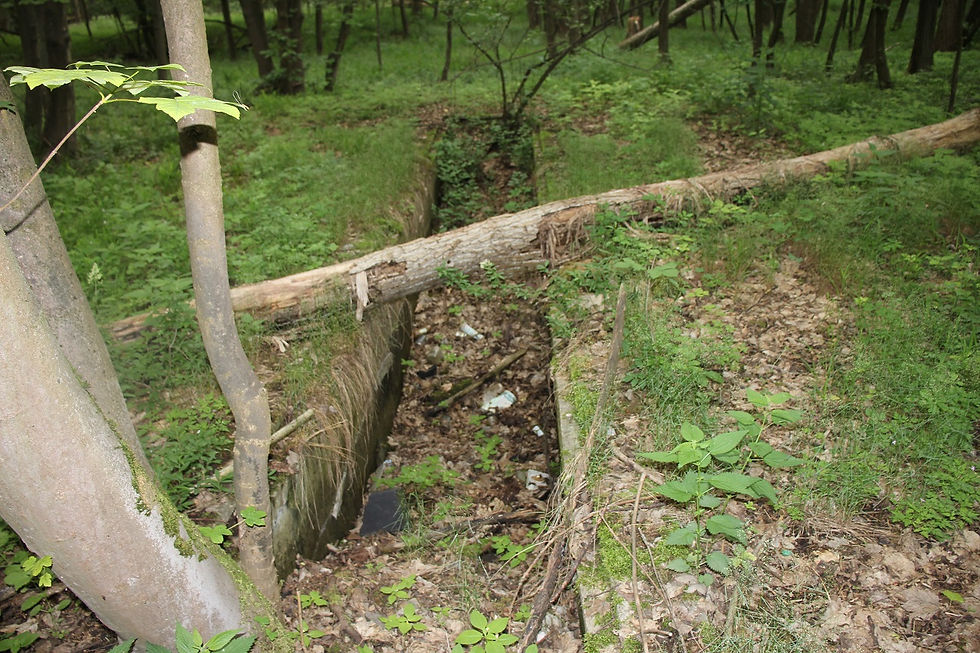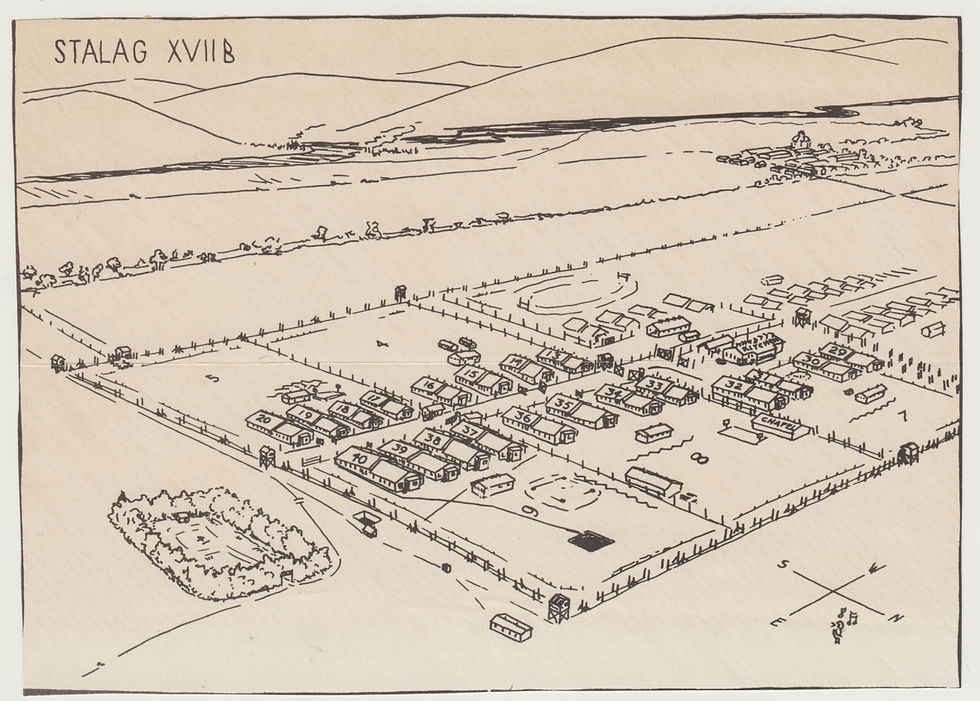Finding What's Left of Stalag 17-B: The Notorious WWII POW Camp
- Gary Toyn
- Feb 2, 2023
- 6 min read
Updated: Nov 5, 2024

What am I doing in the middle of a grove of trees taking a selfie with an old concrete foundation?
It’s not just any grove of trees.
And it's not just any old concrete foundation.
I’m in Austria, and what’s hidden beneath decades of underbrush is all that remains of the infamous Nazi POW camp Stalag 17B.
During World War II, the ground I’m standing on was a place of horrible suffering. It was among the most notorious of all prisoner-of-war camps, detaining as many as 66,000 prisoners—4,200 being American.
For my new World War II novel, I wanted to include this place in my storyline. I did so because of my relationship with the late Ray Matheny, a former POW who lived nearby in American Fork, Utah. He was Nazi prisoner number 105921.

I helped him publish his biography “Rite of Passage: A Teenager’s Chronicle of Combat and Captivity in Nazi Germany.” His story is amazing. On his 9th mission, his B-17 was attacked by flak guns and a swarm of Nazi fighter planes. As the plane began to disintegrate, Ray fell unconscious just as his plane started to spin out of control. He awoke suddenly and had somehow been ejected from the plane and was falling at terminal velocity. When he managed to pull the ripcord on his parachute, it opened just in time for him to land hard in a ditch filled with ice. He suffered a few broken ribs, among other injuries, but he survived and was captured. He considered himself lucky to have survived.
At my last interview before he passed away, this 95-old still spoke with pain in his eyes, remembering the brutality of Stalag 17-B. Of how the Nazi guards tortured prisoners and subjected them to a viciousness that still makes him choke up when he talks about it.
He learned quickly to hate the Nazis. It felt like it was their primary objective to demean and humiliate all prisoners, but especially incoming prisoners. Upon arriving at the camp, each new prisoner was forced to surrender all their personal items like watches, special clothing (like long-johns), jewelry, etc., and the guards often helped themselves to these valuables. After this process, they had to endure a bitter cold shower and then they were sprayed with a delousing chemical. They were given a new German I.D. number and were required to memorize it or endure severe physical punishment.
The camp was filled with enlisted men, and under the terms of the Geneva Convention, they could not be required to work. Consequently, the tedium took its own toll on the prisoners, who had to find ways to keep themselves busy.

To orient myself to the existing relics of the camp I used this old map of Stalag 17 taken by Allied reconnaissance in August 1944. It shows just how large this camp was; almost a square mile in total.
To make prisoners miserable, guards would require all the prisoners to line up for roll call three to four times a day. While this process was ostensibly to keep a tally on prisoners and to detect escapees, the process was often cruel. Despite inclement weather, the “Kriegies” (The German word for war prisoner was Kriegsgefangener or “Kriegies” for short) would stand for hours while the guards conducted an extensive roll call, inspecting ID tags and comparing the faces with their photographs.
After hearing Ray’s story, it inspired me to read other first-hand accounts Stalag 17b. And that’s why one of my key characters is a composite character of many American survivors of this camp.

The more I researched this place, the more I felt a strong need to see it with my own eyes. To get feel for the place. After a bit of digging, I located the GPS location of the old camp, and on a recent trip to Austria, I set out to find it.
Thanks to the fine photoshopping skills of Bob Penoyer, by overlaying the map on a Google image, you can see its location today near Krems, Austria, and more specifically, the town of Gneixendorf.
The 1945 map of Stalag 17B indicating today’s location of the few remaining remnants of Stalag 17-B

The map points to the grove of trees where the only relics of the camp remain. It’s on private property and I had to walk carefully to avoid trampling down the wheat that surrounded this densely forested area that has been left un-managed for decades. I wondered why this plot of land was not reclaimed by a local farmer. Maybe it’s because there are so many concrete structures that it’s just not worth it. Once I found one foundation, I kept finding more.

Concrete remnants of Stalag 17-B

Concrete remnants of Stalag 17-B

Concrete ditch, a remnant of Stalag 17-B
Today, the overgrown trees and moss-covered cement walls are all that physically remains. But there’s more to this place than just concrete relics. I was surprised by the impression I felt that this was hallowed ground. At the time I didn’t know why I had this feeling. It wasn’t until I returned that I realized what makes this place a unique and possible sacred space.
The Russian Experience.
The focus of my initial research was clearly on the American experience, as I wanted to learn about as many details as possible so I include them in my book. But also the dismal rations and food shortages that became a constant concern. Many men lost almost half their body weight, while others lost their minds and were never the same when they returned.
Stalag 17-B camp drawing as conceived by POW Ben H. Phelper

But whatever hell the Americans had to endure, the Russians had it worse. Much worse. What the Soviets were forced to endure was unimaginable. From an American standpoint, the horrible state of the Russians was a constant source of anxiety as they had to watch them slowly die of starvation and exposure. Many Americans risked their lives trying to save the Russians, throwing candy and other food over the wire. Some of these heroes deserve a book on their own.
Why did the Nazi’s single out the Soviets for such harsh treatment? Some of the animosity can be attributed to centuries of conflict between the two peoples. But many historians point to the Russian’s refusal to sign the 1929 Geneva Convention (relating to the treatment of war prisoners.) Consequently, the Nazis knew they were immune from any legal consequence for making the Russians endure such a ghastly sort of hell. And to compound matters, they possessed no compelling moral reason to treat the Russians with compassion or to give them any small degree of human dignity. The predictable result of a lack of objective morality, is death and suffering.
The statistics are mind-boggling. According to the German government’s own post-war figures, of the 5.7 million Russian POWs held by the Nazis, 3.3 million died. That’s a 57% death rate. But at Stalag 17, the conditions tell a similar yet still gruesome story. Although the Russians population made up roughly 22% of the prisoner population, they accounted for 96% of all deaths, 1641 in all.

With a total of 1,714 deaths at Stalag 17-B, the Russians accounted for the vast majority.
Why did I feel like I was walking on hallowed ground? Because over 1,700 men died at this place, under the most desperate and cruelest of circumstances.
In the surrounding area, I noticed a few markers to identify this place as a former POW camp. The most noticeable is the work of an Austrian artist who created four markers on the corners of the original site.

The marker has the word “Remember” written in the twelve different languages representing all the nationalities who were held here. In the artist’s own description of the work, he points out that few people in Krems are aware of the sordid history that existed in their hometown. He stated, “Hardly anyone knows (that) the largest prisoner of war camp in Austria was located here in Krems.”
I also found this marker that also indicates the existence of the camp, and what happened to the bodies that were buried here.

The translation says: “During World War II, this is the site of Stalag 17-B prisoner of war camp. Prisoners of war who died in this camp were either buried in the city cemetery of Krems or transferred to their hometown.”
I could go on and on about this horrible place, but the more I am tempted to tell you, the more I risk revealing spoilers in my book.
But if you ever plan to go to Vienna (Krems is about an hour west of Vienna), hit me up. It's on private property, so I would highly suggest you get permission first. Assuming you've done that, here is the Google directions/GPS location.
For me, the memory of this place has lingered for a long time after I returned home.





Dec 2025
My dad was Captain Thomas Edward Corcoran MD. He was captured by Rommel in North Africa in February 1943. He was placed in 8 different POW camps. At that point he put in a request to the German High Command to be sent where he could practice medicine and help his fellow POWs. As a result he was sent to Stalag 17B and stayed until the end of the war. He and 2 other doctors kept the hospital open and in operation the whole time.
I was told by Sergeant tJohn Wasche, attached to the hospital, that they were totally out of a much needed medication. My dad was allowed to go to a nearby French hospital to…
My wife and I visited the site of Stalag 17B in August 2023 the anniversary of The Our Bay Bee being shot down over Mol, Belgium on the Regensburg bombing mission. The folks in Mol, Belgium were the finest of hosts.
Our travel to Stalag 17B was very relaxing, compared to the hustle and bustle of the train. The scenery was beautiful. Though nothing was there other than the comet markers and the memorial that has been place there, I felt the cold. The hunger, the pain, and emptiness of the prisoners. And when the wind was still and the noise was quite, you could hear the voice’s scream and cry out.
My Dad, Donald McClure was shot down over Steyr and spent about a year in Stalag 17. He wrote a short book about his WWII experiences and gave copies to all of his children and grand children. I'm planning a trip soon to Italy and hopefully will be able to drive up and see where he bailed out and Stalag 17.
My Dad was a 19 year old Corporal tank driver, Headquarters Company ,45th Division of 13th Armored. They helped free this camp and the prisoners who were on the westward march away from the camp with their German guards. The 13th had no idea that the guards were attempting to get prisoners away from advancing Russians, so no, they did not treat the German guards kindly. I think stating the German guards were on a noble mission to save prisoners from the Russians is revisionist history. From what I heard from members of my Dads outfit at 13 Armored Reunions, the German Guards who were terrified of the Russians were trying to save their own necks by cooking up thi…
Anyone interested in a brief written account of time as a POW in Stalag 17B should look to get the book "HELNO-GAL" by Walter Ram, published in 2021. He is still alive and was an American B-17 radio operator that survived being shot down. As of Feb 2025, Walter is 101 years old and regularly holds book signings at the Pima Air and Space Museum in Tucson. We were there and had the honor of speaking with him on 2/24/25. He is very mentally sharp and friendly and would probably entertain any questions you may have about Stalag 17B or men he was with there during the last 19 months of WWII before being liberated.